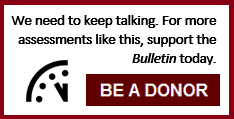A message from Tripoli, Part 4: How Libya gave up its WMD
By William Tobey | December 7, 2014

Part 4: How long does it take to pack and ship a WMD program?
Editor's note: This is the fourth installment of a five-part series exploring the painstaking diplomacy and intelligence efforts that led Libya and its quixotic leader, Muammar al-Qaddafi, to relinquish that country's weapons of mass destruction. The first, second, third, and fifth parts of the series can be found here, here, here, and here, respectively.
Shortly before 9:30 p.m. on January 25th, 2004, Libyan air controllers directed a US Air Force C-17 to a runway on what had been Wheelus Air Base, the former Strategic Air Command outpost just east of Tripoli. When Mahley drove through the base to prepare for the plane’s arrival, he was amazed that he could still recognize buildings that had once housed US airmen and noncommissioned officers. Old road signs still directed traffic in English. The only significant changes Mahley observed on the base since 1979 had been the construction of several mosques. The original runways were still operating. Mahley’s Libyan escorts told him that Qaddafi used the base to welcome guests whom he did not want to subject to normal customs procedures. Qaddafi clearly wanted to avoid the spectacle of a US Air Force C-17 landing at Tripoli’s civilian airport, even at night, and even with its insignia painted over.
With energetic support from the airport ground crew, Americans, British, and Libyans worked side-by-side for almost five hours to load 17 pallets of equipment, including advanced centrifuge rotors based on a Pakistani design and five SCUD-C missile guidance sets, documents related to WMD programs, and heavily packed uranium hexafluoride onto the aircraft. The Libyan airport crew understood some English. For the rest, they communicated by international hand signals, understood by all who work around noisy jet engines. By 2:15 a.m., the last of the material was tied down, and the aircraft was taxiing toward its long journey home.
Aboard the C-17 were in total, some 55,000 lbs. of material. The next day, January 26, the plane landed at McGee-Tyson Air National Guard Base south of Knoxville, Tennessee. There, the National Nuclear Security Administration took possession of the material and stored it in secure facilities at Oak Ridge, TN, where much of it remains to this day.
Mahley and his team continued packing the rest of the materials and equipment for later shipments. They also insisted that Libya consolidate and better secure its stocks of chemical weapons agent. The Americans and British were appalled when they visited three warehouses on the outskirts of Tripoli where the Libyans had stored mustard agent in one and five-liter plastic jugs. The only visible security at each of the sites was a Yale padlock. There were no guards, security cameras, motion detectors, or alarms. At Mahley’s insistence, some 10 tons of mustard agent was moved to a concrete military munitions bunker south of the city of Sirte, deep in Libya’s desert. The stockpile was eventually destroyed in late 2013 and early 2014 by an international effort.
On one of his visits, Mahley decided to inspect the bunker himself. As he approached the building, he got a telltale whiff of the distinctive garlic-like odor of mustard gas. Without wearing full protective gear, he recalled in an interview, he had seen quite enough. Whether or not Qaddafi would have used chemical weapons to suppress the rebellion that ultimately overthrew him, and despite his apparent retention of some munitions, there is no doubt that the dismantlement efforts made it more difficult for him to do so.
On March 1, after the Hajj ended, Mahley and his team returned to Libya. With amazing speed, they finished inventorying and preparing for shipment an additional 1,000 tons of material and equipment, including more centrifuge and missile parts, more than 38 tons of specialty maraging steel, 5 SCUD-C missiles and their transporter-erector-launchers, and components of a pre-fabricated industrial facility to convert uranium ore into uranium hexafluoride gas for use in centrifuge enrichment cascades—55 trailer truckloads of material in all.
In early March 2004, the Industrial Challenger, en route home from duty in Iraq, became the first US-flagged commercial ship to enter a Libyan port since the US air strikes in 1986. As with the planes used to transport WMD materials out of the country, all evidence of the Industrial Challenger’s American origins had been painted over at Libya’s request.
Mahley had only eight days to load the ship. But during the first three days, the Libyans delivered only 10 of the 55 trailer loads to be shipped. After repeatedly badgering Libyan truck drivers to speed up the work, Mahley went to Musa Kusa, the Libyan intelligence chief, late one evening. “Look Musa,” he exploded. “Do you want to get this done or not?” Kusa, who normally replied “Inshallah” (if God wills it) to requests for speedier Libyan action was suddenly accommodating. “Don’t worry Don,” he said insouciantly, “it will all get done.” True to his word, after midnight that night, the Libyans shut down all civilian traffic in Tripoli between the storage depots and the docks. The material and equipment was delivered on time.
The next morning, the wind was up and white caps were whipping across Tripoli’s harbor. Libya’s version of the sirocco, the Ghibli, was blowing hard. Still, the work slowed, but never stopped. Two weeks later, with no fanfare, the Industrial Challenger berthed in Wilmington, NC.
Mahley had one final issue to raise with Kusa: The NSC staff had urged him to try to persuade Libya to agree to end its trade with North Korea, Syria, and Iran. The Bush Administration wanted to set a standard for disarmament that would make it harder for other nations to trade with known proliferators.
At a meeting late one night, Mahley pressed Kusa to forego publicly military trade with North Korea and other proliferators. Not understanding the broader objective the United States had in mind, the head of Libya’s intelligence service, wearing his traditional desert robes, sighed deeply and, by Mahley's account, raised his cap slightly over his head, and let it fall back. “Don,” he said, “I have $5 million worth of North Korean junk out there. Do I look like the kind of man who would make that mistake twice?”
On May 13, 2004 Libya publicly renounced military trade “with states which Libya considers to be of serious weapons of mass destruction proliferation concern.” Later that day, Undersecretary of State John Bolton clarified Libya’s “important” statement by specifying that such states included North Korea, Syria, and Iran.
By mid-March, Libya’s nuclear weapons and longer-range missile programs had been completely eliminated. The remnants of its chemical weapons program were being watched by the Organization for the Prohibition of Chemical Weapons. Total destruction of the arsenals would be accomplished by January 2014, and only after the post-Qaddafi government acknowledged undeclared chemical munitions. American and British experts had been assured that Libya’s biological activities would remain peaceful. Nearly all of this was accomplished in less than four months, and the entire effort, including all of the sometimes-fitful diplomacy, was concluded within a year—one of the most stunning successes in the history of disarmament.
Together, we make the world safer.
The Bulletin elevates expert voices above the noise. But as an independent nonprofit organization, our operations depend on the support of readers like you. Help us continue to deliver quality journalism that holds leaders accountable. Your support of our work at any level is important. In return, we promise our coverage will be understandable, influential, vigilant, solution-oriented, and fair-minded. Together we can make a difference.















